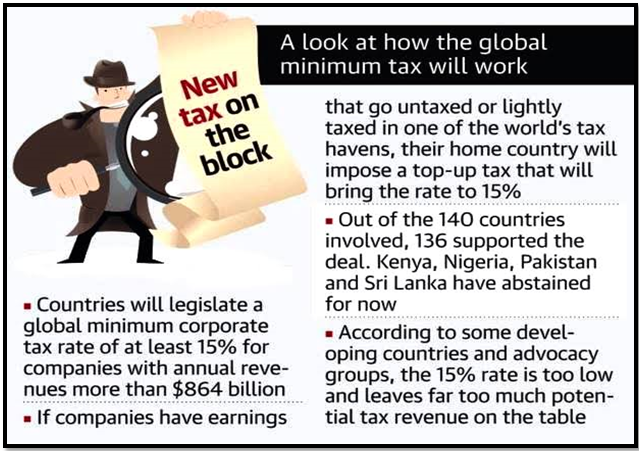GLOBAL MINIMUM TAX: WILL THE BUDGET OFFER A ROADMAP?
Syllabus:
GS 2 : Government Policies and Interventions for Development in various sectors and Issues arising out of their Design and Implementation.
GS 3:
- Taxation
- Effects of Liberalization on the Economy,
Why in the News?
The Indian government is gearing up to introduce the Global Minimum Tax (Pillar Two) as part of its upcoming budget. This move aligns with a global initiative adopted by over 30 countries to ensure multinational enterprises pay a minimum tax rate of 15% in every country they operate.
Source: ET
Understanding Global Minimum Tax
Objectives
Key Points of the Plan Two-Pillar Plan Pillar 1:
Pillar 2:
|
Significant Shift
- Seismic Change: The corporate tax landscape is undergoing a significant transformation globally with the introduction of the Global Minimum Tax, also known as Pillar Two.
- Widespread Adoption: By 2024, over 30 countries had adopted Pillar Two, marking the most significant reform in international tax regulations in a century.
- OECD Framework: Prepared under the OECD’s Inclusive Framework, encompassing over 140 countries, Pillar Two aims to standardize multinational enterprises’ tax obligations.
- Curbing Profit-Shifting: Pillar Two aims to curb profit-shifting by ensuring that MNEs pay a minimum tax in all countries where they operate, targeting those with annual revenues above €750 million.
- Effective Tax Rate: MNEs must pay a minimum effective tax rate (ETR) of 15% on a country-by-country basis, ensuring fair tax contributions globally.
- Top-Up Tax Mechanism: If an MNE’s ETR falls below 15% in any country, a top-up tax is levied to make up the difference, payable to the nation where the MNE’s parent company is based.
How It Works:
- Transformative Mechanics: Should an MNE’s ETR fall below 15% in any country, a supplementary top-up tax is levied, ensuring a minimum tax rate is met.
- Example Scenario: An Indian MNE with subsidiaries in the UAE (ETR of 9%) and Germany (ETR of 30%) would face a 6% top-up tax in India for the UAE shortfall.
- Domestic Minimum Tax: The UAE will have the first right to collect this tax if it enacts a compatible domestic minimum tax, ensuring compliance with Pillar Two.
- Backstop Rule: If neither India nor the UAE enacts Pillar Two, Germany could collect the UAE shortfall through the under-taxed profit rule (UTPR), effective from 2025.
- Single Country Legislation: If even one country legislates Pillar Two, it can collect the entire top-up tax, compelling other countries to implement the initiative.
- Global Implementation: Over 50 countries are at various stages of implementing Pillar Two, ensuring a cohesive global approach to corporate taxation.
Implementation Picking Up Steam
- European Implementation: Countries like the UK, Switzerland, Belgium, the Netherlands, France, Germany, and Ireland have already implemented Pillar Two.
- Asia-Pacific Adoption: Australia, Korea, Japan, and Canada have also implemented Pillar Two, starting this year, ensuring widespread adoption across regions.
- Future Plans: Singapore and Hong Kong plan to roll out Pillar Two in 2025, while the UAE has initiated consultations for its implementation, showing proactive steps.
- Compliance Assessment: Impacted businesses must assess how Pillar Two affects their transactions, ensuring they comply with the new tax regime.
- System Readiness: MNEs must evaluate their systems to accommodate the analytical, compliance, and reporting requirements of Pillar Two, ensuring smooth implementation.
- Navigating Regulations: Given the phased implementation across different jurisdictions, MNEs must navigate a complex landscape of local regulations to remain compliant.
Impact on MNEs
- Extensive Data Needs: Pillar Two analysis and compliance require extensive accounting and tax data, necessitating system upgrades for accurate reporting.
- Proactive Measures: Indian MNEs have initiated or completed preliminary impact assessments, preparing for ongoing compliance and tax provisioning.
- Tax Provisions: MNEs must prepare for potential ETR shortfalls in low-tax countries, ensuring they meet Pillar Two requirements and avoid penalties.
- Competitive Race: The global tax regime will impact existing tax incentives and holiday schemes, necessitating revisions to remain competitive.
- Redesigning Incentives: Countries are redesigning tax incentives to be Pillar Two-compliant, encouraging substantive business activities and limiting ETR impacts.
- Investment Reassessment: MNEs need to consider changes in tax-incentive structures when reassessing ongoing and proposed investments, ensuring alignment with the new tax landscape.
India’s Approach
- Union Budget Anticipation: As India approaches the first full budget of the Modi 3.0 government, anticipation is high for a roadmap addressing Pillar Two taxation.
- Complexity Considerations: Given the complexity of Pillar Two rules, India’s introduction should be preceded by consultations with stakeholders to ensure a smooth transition.
- Stakeholder Consultations: Consultations should focus on integrating Pillar Two with India’s existing tax system and discussing implications for tax incentives in GIFT City, Gujarat.
- Tax Fairness: The growing number of countries implementing Pillar Two signifies a collective stride towards tax fairness, ensuring a level playing field globally.
- Global Mindset Shift: MNEs must shift mindsets, adopting new technologies and ways of operating to align with the truly global tax system brought by Pillar Two.
- Countdown Begins: With the new government’s budget imminent, it is a matter of when, not if, India will embrace this global tax reform, marking the beginning of a new era.
Conclusion
As the implementation of the Global Minimum Tax gains momentum worldwide, India is expected to integrate these regulations into its tax framework. This alignment aims to curb profit-shifting and foster a fairer tax environment, necessitating businesses to reassess their strategies and ensure compliance with the new tax regime.
Source:Indian Express
Mains Practice Question:
Discuss the potential impact of the Global Minimum Tax (Pillar Two) on multinational enterprises operating in India. How should the Indian government prepare for the implementation of this global tax reform to ensure both compliance and competitiveness?
Associated Article:




